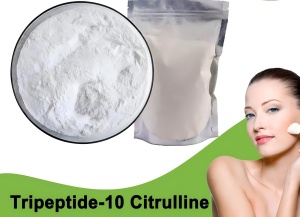Tripeptide-10 Citrulline: Skincare Benefits

Tripeptide-10 Citrulline is a lab-designed peptide ingredient gaining attention in skincare because of its ability to help control collagen fiber formation. Unlike traditional ingredients that simply hydrate or smooth the skin temporarily, this peptide works at a deeper level to manage the structure of the skin. It’s often used in anti-aging formulations to improve firmness, elasticity, and texture, making it a popular ingredient in high-end cosmetic products. Understanding how this peptide works and what it brings to skincare helps both consumers and formulators make more informed decisions.
What Is Tripeptide-10 Citrulline?
Tripeptide-10 Citrulline is a synthetic peptide made from three amino acids, including citrulline. It’s not naturally found in the body but is developed to mimic the skin’s natural peptide functions. Its main role is to regulate the uniformity and size of collagen fibers. Collagen is the protein that gives skin its structure, and when it becomes disorganized or too rigid, skin can start to lose flexibility and develop wrinkles. This ingredient works to keep collagen flexible and well-organized, which supports smoother and younger-looking skin.
How It Works on the Skin
This peptide doesn’t just add something to the skin—it tells your skin how to behave better. Tripeptide-10 Citrulline is often described as a “collagen modifier.” Instead of increasing collagen production like some peptides do, it helps collagen form in a healthier, more natural pattern. That reduces the chances of stiff, tangled collagen bundles, which are common in aging or damaged skin. It works well in synergy with other active peptides and hydrating agents, especially in serums and creams designed for anti-aging purposes.
Benefits in Skincare Products
One of the key reasons Tripeptide-10 Citrulline is used in cosmetics is because of its ability to visibly improve skin texture. It helps the skin look more even and firm over time, especially when used consistently. People with signs of aging such as fine lines or sagging skin may notice more resilience in their skin. It also complements other peptides and ingredients that increase moisture or stimulate skin repair, making it a flexible component in modern skincare formulas.
Safe Use and Skin Compatibility
Tripeptide-10 Citrulline is generally considered safe for all skin types, including sensitive skin. It is non-irritating and doesn’t cause allergic reactions in most users. Because it’s a synthetic peptide, its purity and concentration can be controlled in formulations, which means better stability and performance. It’s usually used at low concentrations—often around 2–5% in a formula—so it’s effective without being overpowering. It’s also stable in a wide pH range, making it compatible with a variety of products like serums, gels, and creams.
How It Compares to Other Peptides
While many peptides focus on boosting collagen production or improving hydration, Tripeptide-10 Citrulline is unique in its ability to structure collagen properly. It’s often used alongside Matrixyl (palmitoyl peptides) or copper peptides to offer both collagen-building and collagen-controlling effects. This layered approach is more advanced and gives formulators more flexibility in developing targeted anti-aging products. It doesn’t compete with other peptides but works in harmony to strengthen the skin’s overall health.


